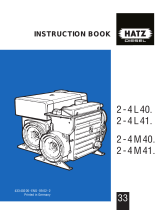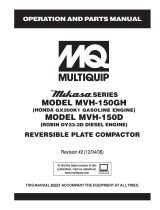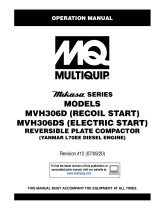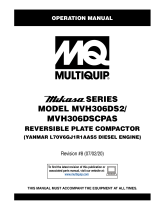Page is loading ...

FB 450
FB 510
USER MANUAL IN ORIGINAL
Dok: 101498-GB 1310

2
FB 450 / FB 510
Dok: 101498-GB 1310

3
FB 450 / FB 510
Dok: 101498-GB 1310
USE
SWEPAC FB 450 / FB 510
are used to pack ballast under foundations, in connection with road
building, in trenches, etc. On account of the forward/reverse fun-
ction, the machine is very suitable for packing in tight spaces and as
a complement to larger packing equipment. The innitely variable
speed control makes it possible to move with great precision and to
pack without moving.
CONTENTS
USE ............................................................................
SAFETY INSTRUCTIONS .......................................
STANDARDS ............................................................
SIGNS ........................................................................
TECNICAL DATA ......................................................
METHOD OF OPERATION .....................................
TECHNICAL DESCRIPTION ...................................
DAILY CHECKS ........................................................
BEFORE STARTING ................................................
STARTING, Yanmar ..................................................
STOPPING ................................................................
BEFORE STARTING.................................................
STARTING, Hatz.......................................................
STOPPING.................................................................
OPERATING INSTRUCTIONS ...............................
TRANSPORTATION .................................................
EC-DECLARATION OF CONFORMITY.................
3
4
4
5
6
6
7
8; 9
10
10
10
11
11
11
12
12
13

4
FB 450 / FB 510
Dok: 101498-GB 1310
STANDARDS
Noise
Measurement in accordance with the standard EN 500-4
Rev. 1:1998, Annex C:
Measurement uncertainty ± 0.5 dB (A) in 95% of the
measurements.
In accordance with the conditions in Directive 2000/14/EC,
Annex VI, the following values are reported:
As the sound pressure level at the operator’s ears exceeds
80 dB (A), ear protectors must be used during operation!
Hand/arm vibrations
The vibration acceleration was measured in accordance
with the ISO 5349 standard during operation on a surface
of macadam. The measurement values were translated
into the maximum daily exposure time for regular usage.
For additional information about vibrations, please confer
the regulation AFS 2005:15 from the Swedish Work
Environment Authority, effective July 1st 2005.
Measurement uncertainty ± 0.3 m/s2 in 95% of the
measurements
SAFETY INSTRUCTIONS
• Before using the machine, the operator must be informed
of the manufacturer’s safety instructions and instructions
for use.
• The machine may only be used outdoors.
• The machine may not be used if protection and safety
devices are not present or not working.
• The operator may not leave the machine unattended when
the engine is on. When the vibrator is connected, the
operator must be able to control the movement of the
machine using the control handle and the start/stop
controls. The machine may be operated only by a trained
operator.
• During maintenance work or other interventions in the
machine, the engine must always be off.
• Switch the engine off before adding fuel. Avoid fuel
spillage and immediately wipe off any spilled fuel. Add
fuel only in well ventilated areas.
• Avoid touching hot engine parts, for example the silencer.
• Before lifting the machine, check that the lifting device
and its mounting are not damaged and that the rubber
dampers on the base plate are undamaged and tightened.
• During transportation and storage, the fuel tank should be
empty and the fuel cock switched off.
• When the machine is parked, ensure that it cannot tip
over. The machine may not incline more than 20º.
• The operator must use ear protectors when working with
the machine.
• The operator must ensure that no unauthorised persons
are in the immediate vicinity of the machine.
• Always wear pesonal protective equipment as heavy,
non-slip shoes, ear protectors and approved eye
protection.
• The machine may not be used in environments in
with potentionell re or explosion danger.
• Never use the machine if you are tired or have
consumed alcohol or are under medication that
could affect your vision, your discretion or you
coordination ability.
• Never use a machine in any way changed from the
original design.
Exhaust Emissions
The FB 450 / FB510 meets the requirements for exhaust
emissions in accordance with US-EPA stage 2.
Sound pressure
level at the oper-
ator’s ears, LpA
Permitted sound
power level, L WA
Guaranteed sound
power level, L WA
FB 450 FB 510
93 dB (A)
108 dB (A)
108 dB (A)
93 dB (A)
108 dB (A)
108 dB (A)
FB 450 FB 510
Hand/arm
vibrations m/s2
The maximum
daily exposure time
2,6
7,4 h
2,6
7,4 h

5
FB 450 / FB 510
1 2 3
7 6
4
5
8MACHINERY
9
Dok: 101498-GB 1310
Before use, carefully read the manual and its safety instruc-
tions so that you can handle the machine safely. Ensure that
the manual is always accessible.
As the sound pressure level at the operator’s ears exceeds 80
dB (A), ear protectors must be used when working with the
machine to prevent hearing damage.
Engine, silencer: to avoid burns or discomfort, do not touch
hot engine parts when the engine is on or when the machine
has recently been used.
1. Manufacturer
2. Place, country of manufacture.
3. CE mark.
4. Model name.
5. Year of manufacture.
6. Max. engine power.
7. Max. weight.
8. Serial number.
9. Machine type
SIGNS
Warning Signs Machine Signs

6
FB 450 / FB 510
Dok: 101498-GB 1310
FB 450
Net weight .................................445 kg
Base plate, w x l ........................700 x 1080 mm
Speed .........................................approximately 25 m/min
Permitted inclination ................20°
Centrifugal force .......................60,000 N
Vibration frequency ..................72 Hz
Drive engine ..............................Yanmar L 100AE
Engine power ............................7 kW
Engine RPM ..............................3000 RPM
Fuel tank volume .......................5.5 liter
Fuel type ....................................Diesel
Battery capacity ........................40 Ah
Generator power ........................180 W (15 A)
TECHNICAL DATA METHOD OF OPERATION
The machine consists of a base plate with a vibration
element and an upper part cushioned from the base plate.
The cushioning between the base plate and the upper part
consists of four rubber dampers. The upper part, on which
the drive engine is mounted, is also designed as a hydraulic
oil tank. The control handle is placed on the upper part and
cushioned with rubber dampers. The vibration element is
driven and the direction of travel is changed by means of hy-
draulics. The hydraulic pump, mounted on the diesel engine,
supplies a hydraulic motor on the vibration element with an
oil ow. The vibration element consist of two shafts on roller
bearings with bias weights that are connected to gear wheels
that rotate in opposite directions. One gear wheel can rotate
on its shaft by means of a hydraulic cylinder. This changes
the mutual phase positions of the eccentric weights and the
direction of travel of the machine, and the speed is changed
innitely variably. All parts are well protected against da-
mage in connection with use and transportation by a sturdy
protective frame with a hood of impact-resistant ABS.
FUEL and OIL RECOMMENDATIONS
Fuel ...........................................Diesel
Engine oil ..................................SAE10W-30
Oil quantity, crankcase ..............1,5 liter
Engine oil change diesel engine: rst oil change after 50 hours
then every 200 hours of operation. Replace the lter when you change oil.
Hydraulic oil type / quantity .........HydraWay BIO SE 32-68.......35 liter
Replace hydraulic oil lter.....................................................after 3 years
Oil type/quantity, vibration unit........SAE10W-30.........................0,5 liter
FB 510
Net weight .................................500 kg
Base plate, w x l ........................700 x 1080 mm
Speed .........................................approximately 25 m/min
Permitted inclination ................20°
Centrifugal force .......................66,000 N
Vibration frequency ..................72 Hz
Drive engine ..............................Hatz 1D50Z
Engine power ............................7.5 kW
Engine RPM ..............................3000 RPM
Fuel tank volume .......................5.5 liter
Fuel type ....................................Diesel
Battery capacity ........................40 Ah
Generator power ........................180 W (15 A)

7
FB 450 / FB 510
1 2
345
67
8
9
11 10
13
14
12
15 16 17 18
19
20
21
22
23
24
Dok: 101498-GB 1310
TECHNICAL DESCRIPTION
FB 450 / 510
Left side view
Right side view
1. Protective hood
2. Lifting eye
3. Diesel engine
4. Control panel
5. Hydraulic tank
6. Control handle
7. Forward/reverse control
8. Vibrator and handle heating switch
9. Base plate
10. Rubber damper
11. Battery
12. Vibration element
13. Protective lock, left side
14. Hydraulic pump
15. Battery cover
16. Hydraulic oil lter
17. Throttle lever
18. Air lter
19. Protective frame
20. Protective lock, left side
21. Protective list
22. Hydraulic oil cooler
23. Air inlet. lock
24. Transport locking device
Left side view Right side view

8
FB 450 / FB 510
FB 450 FB 510
1 2 34
5
FB 450
1 2 3
4
5
FB 510
Dok: 101498-GB 1310
1. Indicator
2. Filter plate
3. Filter
4. Cap
5. Air intake with cyclone
Cleaning
With the engine at full RPM, press in the indicator (1) for the
air lter. If it remains depressed, clean the llter as described
below. This may need to be done several times a day in dusty
conditions.
1. Loosen the wing screw in the llter cap (5). Check that the
dust outlet (4) is not clogged. Clean it if necessary.
2. Loosen the llter (3) and blow it clean with dry
compressed air, max. 5 bar, from the inside until no more
dust comes out. Replace a damaged llter.
3. Check that the lter plate (2) in the lter housing is clean.
DAILY CHECKS
Oil/Fuel Leakage
Check every day that the engine is not leaking oil or fuel. If a
leak is discovered, the machine may not be operated until the
fault has been remedied.
Air Filter Check
The air lter must be checked at least once every working
week. When working in dusty conditions, check daily.
Fuel Check
Check that there is fuel in the tank. Top up if necessary.
Engine Oil Level Check
Check the oil level in the crankcase every day. Turn off the
enginethe. The machine is on a level surface.
FB 450: The oil must reach the edge of the lling hole.
FB 510: The oil must reach up to the “MAX” marking.
1. Filter plate
2. Foam plastic element
3. Paper element
4. Filter cover
5. Cyclone lter collector
Cleaning
1. Remove the foam plastic element and the paper element
and check that they are undamaged. Replace damaged parts.
2. Wash the foam plastic element in liquid with a high as-
hpoint and let it dry properl. Dip in engine oil and squeeze
dry.
3. Strike the paper element against a hard object a few times
to loosen any dirt.
4. Check that the lter plate is clean. Clear the cyclone lter
collector.

9
FB 450 / FB 510
12
3
Dok: 101498-GB 1310
Oil level
4cm
Hydraulic Oil Level Check
Check every day that the hydraulic connections do not leak
or wear during operation. The oil level in the tank must be
according the picture, approximately 4 cm below from the
top of the tank. Fill up hydraulic oil as described below.
Remove the battery cover. Remove the tank cover (1).
Remove the lter (2). Fill up hydraulic oil and reassemble
lter and cover. The cover must be well tightened when
reassembling.
Vibration Element
Check regularly that there is no oil leak. Seal any leaks.
Note! Machines must never be operated if a leak is sus-
pected.
Note! The oil level in the vibration element is 0,5 liter.
Rubber Damper
Check the condition of the rubber dampers regularly.
Replace damaged dampers.
Hydraulic Oil cooler
The machine is equipped with a hydraulic oil cooler. The
cooler start working when the hydraulic oil reach a
temperature +50 ˚C. Afterwards subsequently switch to and
from the coolers as necessary. After shutting off the
machine, the cooling fan run for a short time, which is
normal.
Note! If the indicator light for hydraulic temperature (see
the panel picture for each machine) lights red it indicates
that the hydraulic oil temperature is to heat. Continue dri-
ving the machine means worse compaction capability. Stop
and check the hydraulic oil cooler.

10
FB 450 / FB 510
12 3 4 5
FB 450
Dok: 101498-GB 1310
Yanmar decompression handle
Turn off the vibration. Switch the throttle lever (5) to idle
and let the engine run for a few minutes.
Press the engine power switch (1) upwards (O marking).
Stop the engine by moving the throttle lever to the stop
position (4)
FB450 instrument panel with;
1. Engine power switch
2. Control lamps for charging, oil pressure and
hydraulic oil temperature
3. Full throttle position
4. Stop mode
5. Throttle
BEFORE STARTING
See Daily Checks on page 8.
STARTING
Vibration power switch and
handle heating
STOPPING
At the End of the Day
Close the fuel cock.
Note! The vibration power switch on the handle must be in
the position “vibration off” (red/green marking). Other-
wise the machine cannot be started.
Open the fuel cock.
Switch the throttle lever (5) to the full RPM position (3).
Start the engine with the power switch (1). Place the knob
in the central position and check that the charging and oil
pressure lamps (2) light up. With the power switch in this
position the buzzer starts to sound. Then press the power
switch down (Start marking).
Note! Never run the starter motor for longer than 10 seconds
at a time. If the engine does not start, wait 15 seconds before
trying to start it again.
In very cold weather or if the battery capacity is low for
a different reason, starting can be facilitated using the
decompression handle in connection with the valve housing.
Press the lever down and hold it down until the ywheel has
reached its maximum RPM. Run the engine warm for around
5 minutes.
Yanmar fuel cock
Open
Closed

11
FB 450 / FB 510
1 2 3 4 5
FB 510
Dok: 101498-GB 1310
Main power switch
FB510 instrument panel with;
1. Control lamps for the engine, charging, oil pressure and
hydraulic oil temperature
2. Starter key
3. Full throttle position
4. Stop mode
5. Throttle
Vibration power switch and
handle heating
Hatz decompression handle
BEFORE STARTING
See Daily Checks on page 8.
STARTING
Note! The vibration power switch on the handle must be in
the position “vibration off” (red/green marking). Other-
wise the machine cannot be started.
Switch the throttle lever (5) to the full RPM position (3).
Insert the starter key (2) in position 0 and turn to the position
1 and check that the charging and oil pressure lamps (1) light
up. With the starter key in this position 1 the buzzer starts to
sound. Turn the starter key to the position 2. Release the key
as soon as the engine starts. It returns to position 1 and will
remain in that position during operation. Charging and oil
pressure light goes off immediately after the start. Engine light
(1) lights green while the engine is running.
Note! Never run the starter motor for longer than 10 seconds
at a time. If the engine does not start, wait 15 seconds before
trying to start it again.
In very cold weather or if the battery capacity is low for
a different reason, starting can be facilitated using the
decompression handle in connection with the valve housing.
Press the lever down and hold it down until the ywheel has
reached its maximum RPM. Run the engine warm for around
5 minutes.
STOPPING
Turn off the vibration. Switch the throttle lever (5) to idle
and let the engine run for a few minutes.
Turn the starter key to the position 0.
Stop the engine by moving the throttle lever to the stop
position (4)

12
FB 450 / FB 510
1
Dok: 101498-GB 1310
The vibrator is started and stopped with the power switch on
the handle.
When the control hoop on the handle is moved backwards,
the machine reverses and when the hoop is moved forwards,
the machine moves forwards. The speed is controlled by
how long the control hoop is activated.
The machine is only designed to be used outdoors. Work
with the machine in daylight or other adequate lighting.
Ballast must be wetted or naturally damp. All other use is
discouraged.
Note! When moving up a slope, the machine should be
reversed.
The machine may not incline more than 20º when in use or
parked.
Handle Heating
For increased comfort, the machine has an electrically hea-
ted handle. The handle heating is activated with the power
switch on the handle and can only be used when the vibrator
is connected, which prevents the heating coil from dischar-
ging the battery when the machine is not being used.
Transport locking
Secure the machine with straps accorrding to illustration
during transportation
OPERATING INSTRUCTIONS TRANSPORTATION
The machine is tted with a lift eye that can be be placed on
the hood when not in use.
NOTE! Use only safety frame lifting point (1) to lift the
machine.
Check before lifting that the lifting eye and its mounting
on the machine are undamaged. Check also that the base
plate’s rubber dampers are undamaged and rmly attached.
For transportation by vehicle, the handle must be folded
forwards and locked with the transport locking device. The
machine must then be secured with, for example, approved
straps. Note! Secure it by the base plate and not the rubber-
cushioned upper part.

13
FB 450 / FB 510
Dok: 101498-GB 1310
EC-declaration of conformity
Manufacturer
Swepac AB
Blockvägen 3
34132 Ljungby
1. Category: Vibratory plate
2. Type: FB450
FB510
3. Engine power: FB450..........................7kW
FB510........................7,5kW
The product complies with the following directives:
2006 / 42 / EG
2000 / 14 /EG
2004 / 108 / EG
EN 500-1
EN 500-4
Technical documentation held by:
Swepac AB, Blockvägen 3 SE-34132 Ljungby
Tomas Johansson / Product Engineer

14
FB 450 / FB 510
Dok: 101498-GB 1310

15
FB 450 / FB 510
Dok: 101498-GB 1310

16
FB 450 / FB 510
Dok: 101498-GB 1310
SWEPAC AB
Address Blockvägen 3, 341 32 Ljungby, Sweden, tel. +46 (0)372-156 00, fax +46 (0)372-837 41, E-mail [email protected],
Internet www.swepac.se
/








